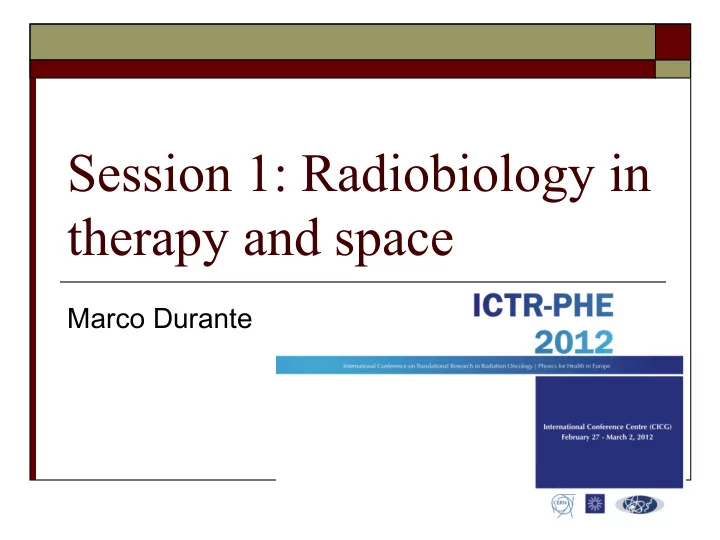

Session 1: Radiobiology in therapy and space Marco Durante
Status & Perspectives in Particle Therapy – Alejandro Mazal Worldwide He, ¡pions, ¡ Tot ¡per ¡ Patients M.Jermann End ¡of ¡year ¡ Total ¡ Protons ¡ Carbon ¡ others ¡ year ¡ A.Mazal Statistics 2007 ¡ 61855 ¡ 53818 ¡ 4450 ¡ 3587 ¡ ¡ ¡ PTCOG 2008 ¡ 70051 ¡ 61122 ¡ 5342 ¡ 3587 ¡ 8196 ¡ yesterday 2009 ¡ 76266 ¡ 67097 ¡ 5582 ¡ 3587 ¡ 6215 ¡ 26/02/12 2010 ¡ 84492 ¡ 73804 ¡ 7101 ¡ 3587 ¡ 8226 ¡ 93547 ¡ 9055 ¡ 2011 ¡ 81121 ¡ 8839 ¡ 3587 ¡ 100,000 90,000 80,000 70,000 60,000 Total 50,000 Protons 40,000 Carbon 30,000 He, pions, others 20,000 10,000 0 2006 2007 2008 2009 2010 2011 2012
Status & Perspectives in Particle Therapy – Alejandro Mazal Depth dose distribution for ions U. Weber
Damage complexity is largely dependent on ionisation density of the radiation Clustered damage 30-40% low-LET = complex Simple DSB 90% high-LET = Complex DSB complex 100 90 80 low LET high LET 70 percentage of total 60 50 40 30 Peter O'Neill - Molecular basis 20 for the relative biological 10 effectiveness of densely ionizing 0 radiation or more 1 2 3 number of lesions in cluster
20 MeV protons 55 MeV carbon 20 MeV protons 5 × 5 µ m ² matrix 5 × 5 µ m ² matrix randomly distributed 117 protons per spot 10 µ m 10 µ m 10 µ m Günther Dollinger - Low LET radiation focused to sub-micrometer shows enhanced radiobiological effectiveness (RBE)
Early radiation-induced vascular damage Pulmonary Hypertension Right Ventricle Hypertrophy Early radiation-induced Pulmonary/Cardiac function loss vascular damage Limits tumor dose escalation Sonja van der Veen, Angiostatin-converting enzyme (ACE) inhibition ameliorates University of Groningen, pulmonary/cardiac function, but only when the heart is co- irradiated The Netherlands
Simulation results Rachel DELORME Dose deposition around a AuNP of 100nm CEA, LIST, France • Dose deposition at 500nm around a AuNP of 100nm with a 85 keV X-ray beam. § In water § With a centred AuNP 1 µ m 1 µ m Dose (eV/g) Dose (eV/g) 1e14 8e11 X-ray X-ray 8e13 source source 6e11 NP 6e13 Z Z 4e11 4e13 2e11 2e13 0 0 X X § AuNP : Increase of the dose up to a factor 100 with quasi-isotropic diffusion. ■ 7
Michael Krämer
Michael Krämer
Uwe Schneider, Cancer risk above 1 Gy and the impact for space radiation 6 protection 5 4 REID in % Lunar, long (0.084 Sv) 3 Mars, swing (1.03 Sv) 2 Mars, surface (1.07 Sv) 1 0 NASA our work NASA our work estimate estimate
Status & Perspectives in Particle Therapy – Alejandro Mazal Ex : How potential applications and solutions can be suddenly affected: Use of passive delivery systems of proton beams for pediatric treatments Measured Neutron Dose at LLUMC 1 Hall's Paper, HCL (160 MeV) Neutron Dose equivalent/ Proton Dose LLUMC Snoopy Neutron Detector 0.1 (250 MeV) LLUMC CR39 Detectors (250 MeV) Yan's Paper, HCL, Boston Bonner 0.01 Spheres (160 MeV) MPRI, Neutron Bubble detector (150 Mev) SOI Microdosimeter (225MeV) 0.001 Expon. (Hall's Paper, HCL (160 MeV)) 0.0001 0 20 40 60 80 100 120 140 Distance from Field Edge (cm) Courtesy of A. Wroe C. Rossi-LLUMC. ESTRO 2007
Miralbell � (medulloblastoma) � PEDIATRICS � � Status & Perspectives in Particle Photons � Therapy – Alejandro Mazal Issues: � St.Clair & al, MGH � T.control � � IMXT � Sequelae � Secondary T � Cognigtive � Electrons � … � + photons � � Gaboriaud & al, Curie � Protons � � (court.Varian) Lomax & al, PSI �
Secondary Malignant Neoplasms (SMN) in particle therapy Comparison of relative radiation dose distribution with the corresponding relative risk distribution for radiogenic Radiation Absorbed Dose second cancer incidence and mortality. This 9-year old girl received craniospinal irradiation for medulloblastoma using passively scattered proton beams. The color scale illustrates the difference for absorbed dose, incidence and mortality cancer risk in different Risk of SMN Mortality organs. Newhauser & Durante, Nature Rev. Cancer 2011 Risk of SMN Incidence
In patient dosimetry (uterus dose for a pregnant woman) Total dose < 0.3 mSv Very low stray radiation reduced risk of secondary cancers or teratogen effects Münter et al., Fertil Steril. 2010
Status & Perspectives in Particle Therapy – Alejandro Mazal CONCLUSIONS We know how to deal with the technology, but is bulky and, mainly, too expensive Protons stops but we do not know exactly where Ions have a strong biological effect, but we do not know exactly the values Thousands of patients have been treated but there are critics on the lack of clinical trials In spite of the experience of the existing centers there are still non realistics business plans
~ 200 shifts/year for reducing uncertainty on cancer risk from 1500% to 50% in 20 years
Outlook • Most of the uncertainty in particle therapy and space radiation protection is due to biology, not physics • Physics can lead to significant technical improvements and reduced costs but biology can lead to major breakthrough • Hot topics are RBE, genetic background, hypofractionaction, vascular damage, nanotechnologies, adaptive TP, angiogenesis, metastasis, late effects and second cancers • Beamtime and easier access to facilities needed
Recommend
More recommend